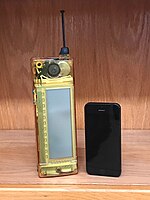IBM Simon
[10] With advances in MOSFET (metal–oxide–semiconductor field-effect transistor, or MOS transistor) technology enabling smaller integrated circuit chips be powered[11] and the proliferation of wireless mobile networks,[12][13] IBM engineer Frank Canova realised that chip-and-wireless technology was becoming small enough to use in handheld devices.
[14] IBM debuted a prototype device, code named "Sweetspot",[15] on November 16, 1992,[16][17] at the COMDEX[18] computer and technology trade show in Las Vegas, Nevada, United States.
The Sweetspot prototype combined a mobile phone and PDA into one device, allowing a user to make and receive telephone calls, facsimiles, emails and cellular pages.
Not only did the prototype have many PDA features including a calendar, address book and notepad, but also demonstrated other digital services such as maps, stocks and news before they were widely available.
[2][21][22] After a very successful prototype demonstration at COMDEX, IBM began work on the commercial product, code named "Angler".
[6] BellSouth executives gave the finished product its final name, "Simon Personal Communicator", before its public debut at the Wireless World Conference in November 1993.
Simon featured many applications, including an address book, calendar, appointment scheduler, calculator, world time clock, electronic notepad, handwritten annotations, and standard and predictive stylus input screen keyboards.

